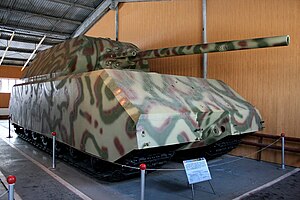This article includes a list of general references, but it lacks sufficient corresponding inline citations. (March 2022) |
| Panzerkampfwagen VIII Maus | |
|---|---|
 The Maus hybrid V1/V2 prototype at the Kubinka Tank Museum, Russia (2009) | |
| Type | Super-heavy tank |
| Place of origin | Nazi Germany |
| Service history | |
| Used by | Nazi Germany |
| Wars | World War II |
| Production history | |
| Designer | Ferdinand Porsche |
| Designed | 1941 |
| Manufacturer | Ferdinand Porsche, Krupp, Alkett |
| Produced | 1944 |
| No. built | 2 |
| Variants | V1, V2 |
| Specifications | |
| Mass | 188 t (207 short tons; 185 long tons) |
| Length | 10.2 m (33 ft 6 in) |
| Width | 3.71 m (12 ft 2 in) |
| Height | 3.63 m (11 ft 11 in) |
| Crew | 6 (commander, gunner, 2 loaders, driver, radio operator/bow gunner) |
| Armour | |
Main armament | 128 mm (5 in) KwK 44 gun L/55 (68 rounds)[1] |
Secondary armament |
|
| Engine |
|
| Power/weight | 6.4 HP/ton[1] |
| Ground clearance | 500 mm (20 in) |
| Fuel capacity |
|
Operational range |
|
| Maximum speed | |
Panzerkampfwagen VIII Maus (English: 'mouse') is a German World War II super-heavy tank completed in July of 1944. It is the heaviest fully enclosed armored fighting vehicle ever built. Five were ordered, but only two hulls and one turret were completed, the turret being attached before the testing grounds were captured by advancing Soviet military forces.
These two prototypes underwent trials in late 1944. The complete vehicle was 10.2 m (33 ft) long, 3.71 m (12.2 ft) wide and 3.63 m (11.9 ft) high. Weighing about 188 metric tons, the Maus's main armament was the Krupp-designed 128 mm KwK 44 L/55 gun, based on the 12.8 cm Pak 44 towed anti-tank gun also used in the casemate-type Jagdtiger tank destroyer, with a coaxial 75 mm KwK 44 L/36.5 gun. The 128 mm gun was powerful enough to destroy all Allied armored fighting vehicles in service at the time, with some at ranges exceeding 3,500 m (3,800 yd).[4]
The principal problem in the design of the Maus was developing an engine and drivetrain powerful enough to adequately propel the tank, yet small enough to fit inside it – as it was meant to use the same sort of "hybrid drive", using an internal-combustion engine to operate an electric generator to power its tracks with electric motor units, much as its Porsche-designed predecessors, the VK 30.01 (P), VK 45.01 (P), and Elefant had. The drivetrain was electrical, designed to provide a maximum speed of 20 km/h (12 mph) and a minimum speed of 1.5 km/h (0.9 mph).[5] However, during actual field testing, the maximum speed achieved on hard surfaces was 13 km/h (8.1 mph) with full motor field, and by weakening the motor field to a minimum, a top speed of 22 km/h (14 mph) was achieved.[6] The vehicle's weight made it unable to use most bridges; instead it was intended to ford to a depth of 2 m (6.6 ft) or submerge up to a depth of 8 m (26 ft) and use a snorkel to cross rivers.[7]
- ^ a b c d e f g h i j k Jentz, Thomas; Doyle, Hilary (2008). Panzer Tracts No. 6-3 Schwere-Panzerkampfwagen Maus and E 100 1942 to 1945. Panzer Tracts. p. 47. ISBN 978-0981538235.
- ^ "War Machines: Maybach-Powered Panzer Tanks". 9 June 2018.
- ^ "Mercedes-Benz 500 Series Diesel Marine Engines". 5 March 2017.
- ^ Parada, George. "Panzer VIII Maus". Achtung Panzer.
- ^ Jentz, Thomas; Doyle, Hilary (2008). Panzer Tracts No.6-3 Schwere Panzerkampfwagen Maus and E 100 Development and Production from 1942 to 1945. Panzer Tracts/Darlington Publications. p. 3. ISBN 978-0-9815382-3-5.
- ^ Forty, George (1987). M.G. Burns (ed.). German Tanks of World War Two in Action. Blandford Press. p. 144. ISBN 0-7137-1634-7.
- ^ Young, Aaron (2020-12-12). "10 Crazy Facts About The Panzer VIII Maus, The Biggest Tank Ever Built". HotCars. Retrieved 2023-12-14.